Reading Time: 7 minutesWhether it was a mistaken press of a button or a technical issue, losing your photos from Fujifilm camera can be devastating. However, you can quickly recover your lost files with the right tools and techniques. In this blog post, we’ll walk you through step-by-step instructions on recovering deleted photos from a Fujifilm camera.
Is It Possible to Recover Photos from Fujifilm Camera?
Yes, it’s highly likely to recover your lost photos from a Fujifilm camera in most cases. However, the success of the recovery will depend on the reason for deletion. Here are the different reasons in detail:
- 🗃️Formatting: Sometimes, the camera might ask you to format the card if it detects a problem. In this case, if you’ve formatted your SD card directly in the camera or performed a full format after connecting it to your PC, it’s impossible to recover your files. However, suppose you’ve only done a quick format on your computer. In that case, you can still get your photos back using data recovery software.
- ⚠️Firmware Issues: Outdated or corrupt firmware can cause reading and writing errors, compatibility, and even formatting issues, eventually leading to data loss in Fujifilm cameras. To avoid this, keep your Fujifilm camera’s firmware up-to-date by downloading and installing the latest updates directly on your camera or from the official Fujifilm website.
- 📊Corruption: Removing the SD card while the camera is on, or having the battery die during data transfer, can lead to SD card corruption. In this case, the success rate entirely depends on the extent of the corruption and the reason behind the corruption. In some cases, data recovery software may still be able to retrieve lost files. In contrast, you may have to contact professional data recovery services in other cases.
- 🛡️Physical Damage: If your camera’s SD card suffers physical damage due to dropping, water exposure, overheating, or extended use in high temperatures, the chance of recovering your photos depends on the extent of the damage. Data recovery software might do the trick if the SD card still appears in your PC’s device manager. If not, it’s time to contact a data recovery service.
- 🦠Virus: When you connect your Fujifilm camera or its SD card to a computer infected with malware, the virus can also infect the camera’s storage or memory card, potentially leading to data loss or corruption. If a virus has infected the SD card and caused photo deletion, the chances of recovery depend on the type of virus and its effects. Some viruses can be removed using antivirus software, after which data recovery software may be able to restore the lost files. In other cases, the virus may have caused irreversible damage, making a recovery more difficult or even impossible.
How to Recover Deleted Files from Fujifilm Camera
There are two primary methods for recovering deleted photos from Fujifilm cameras: a third-party app or a professional data recovery service.
Let’s look at these two methods in detail to recover deleted files from Fujifilm cameras:
Method 1: Use Data Recovery Software
The easiest way to recover deleted photos from Fujifilm cameras is to use data recovery software like Disk Drill. It is one of the most versatile data recovery programs on the market. It can easily recover photos and videos shot by Fujifilm cameras. However, for maximum success, you need to act quickly and start the recovery process as soon as you notice that photos are lost from your Fujifilm camera.
Disk Drill offers a free trial for Windows users, so you can recover up to 500 MB of data for free.
To get started with file recovery, follow these steps:
- Download Disk Drill from the official website and install it on your computer.
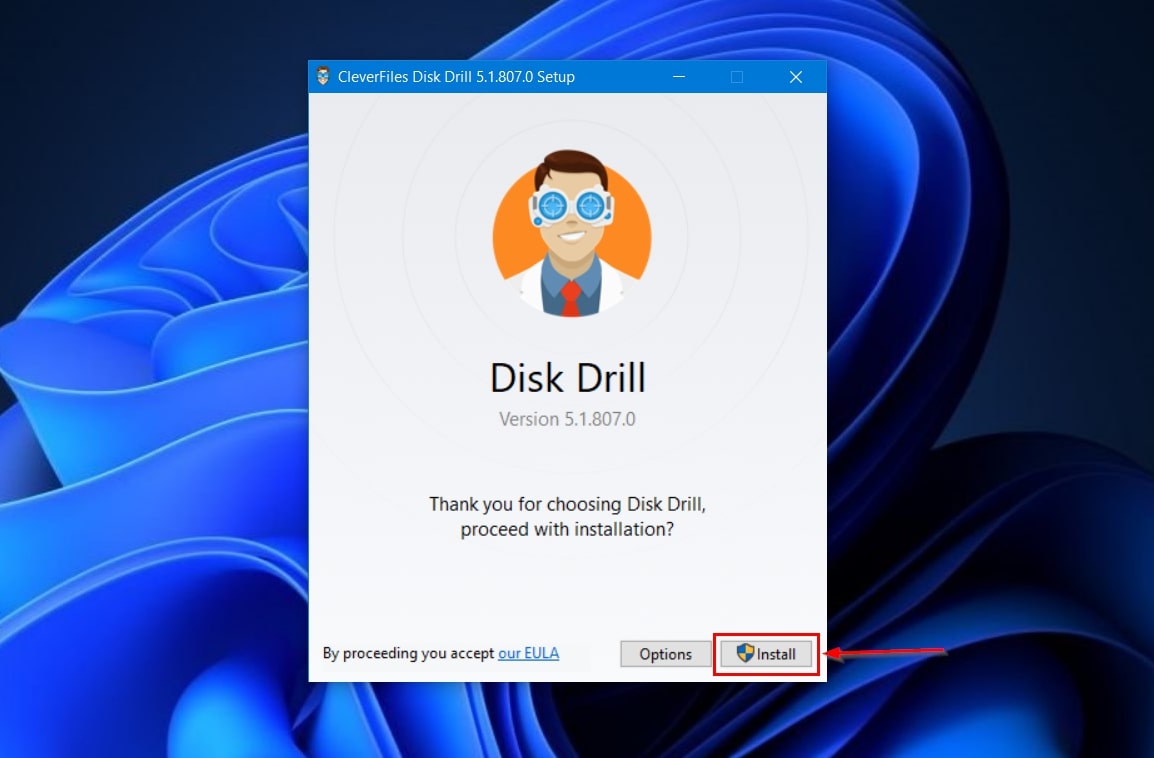
- Launch Disk Drill and insert the SD card from your Fujifilm camera into your PC when the installation is complete.

- Select the SD card from the Device/Disk list from which you want to recover the files.
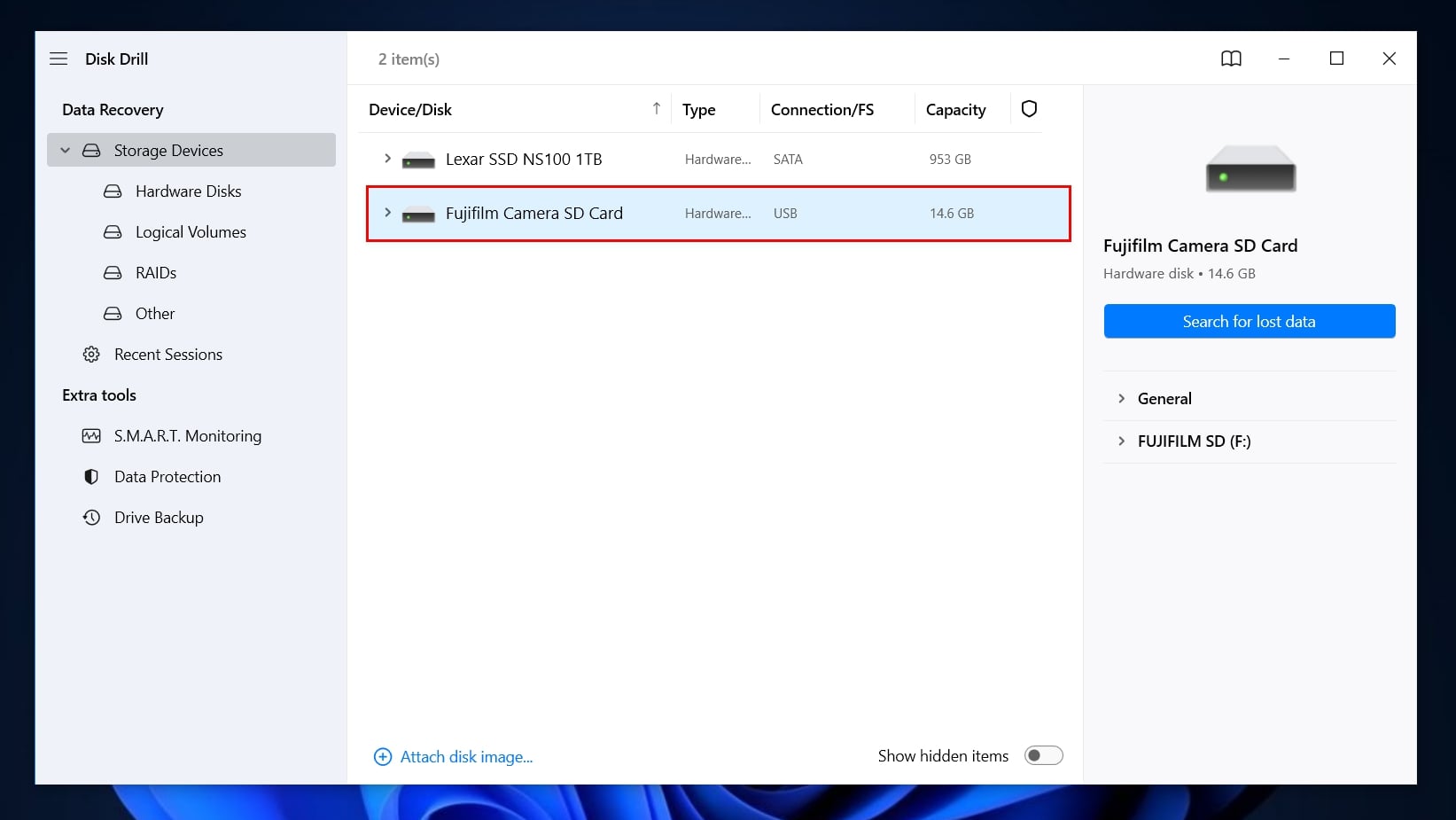
- Next, click Search for lost data to start the search process.
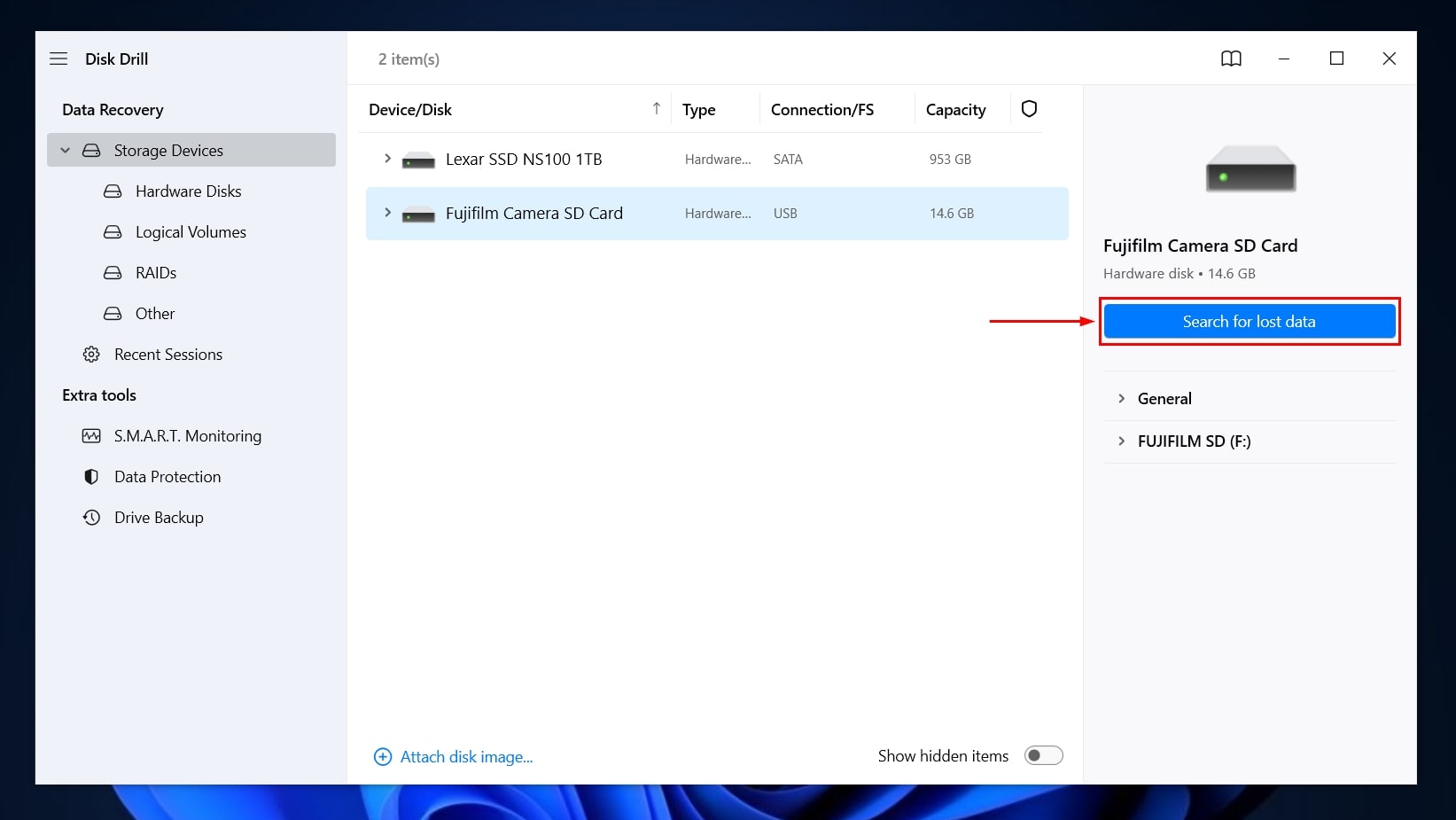
- You can see the recovery progress at the top. You do not need to wait for Disk Drill to complete the scan. You can click on the Review found items on the top and view the recovered files. Disk Drill will add more files to the found section in the background.
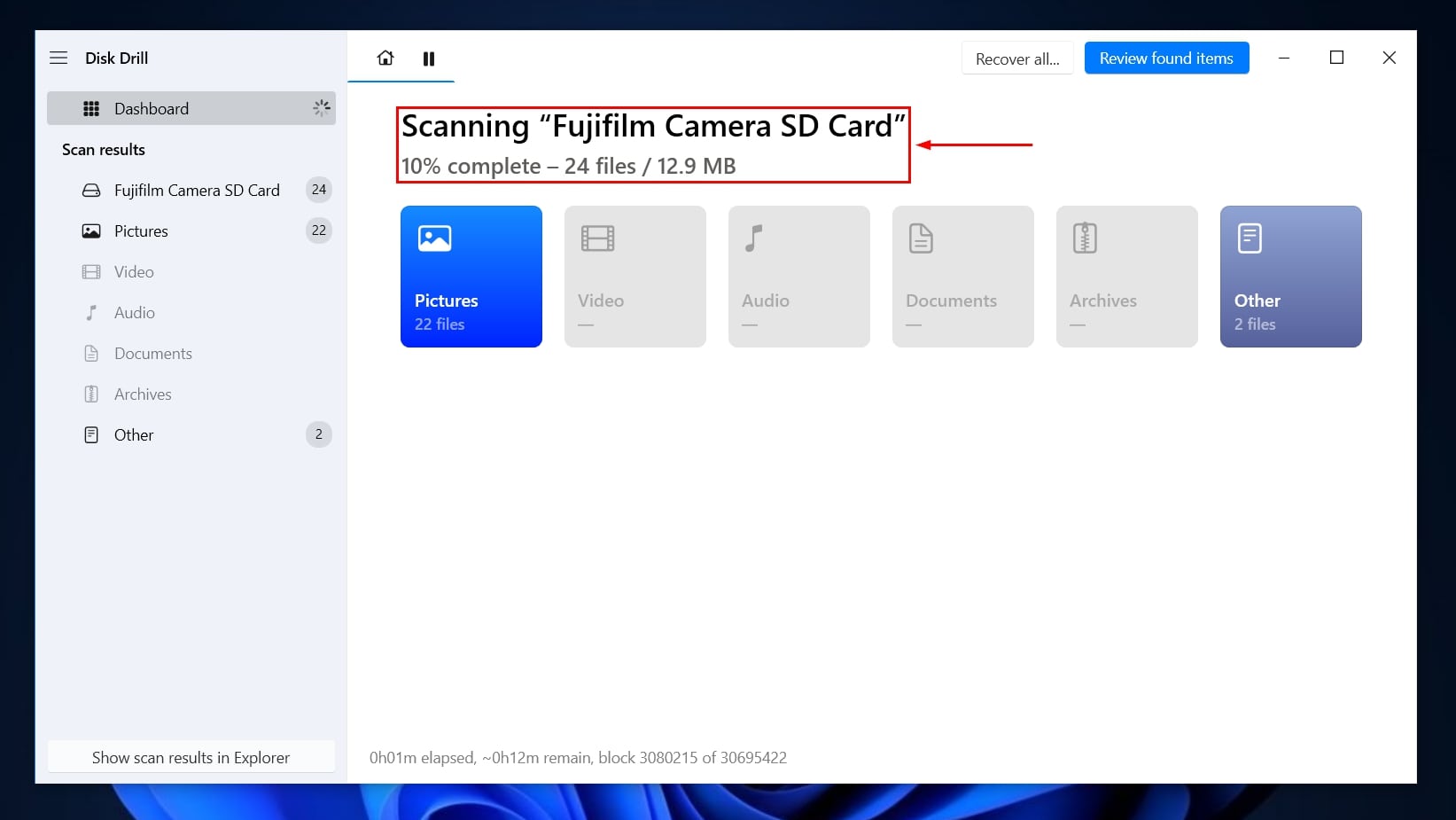
- You can easily sort through the discovered photos by filtering them based on categories in the sidebar or using the filters in the right panel. You can also directly search for photos by name or by typing “.RAF” to only show photos that are in Fujifilm camera’s file extensions using the search bar on the top-right corner. You can also see a quick preview of each photo on the right side of the window by clicking the small eye button without having to recover it first.

- Now locate and select the files you want to recover. Then, click the Recover button to start the process.
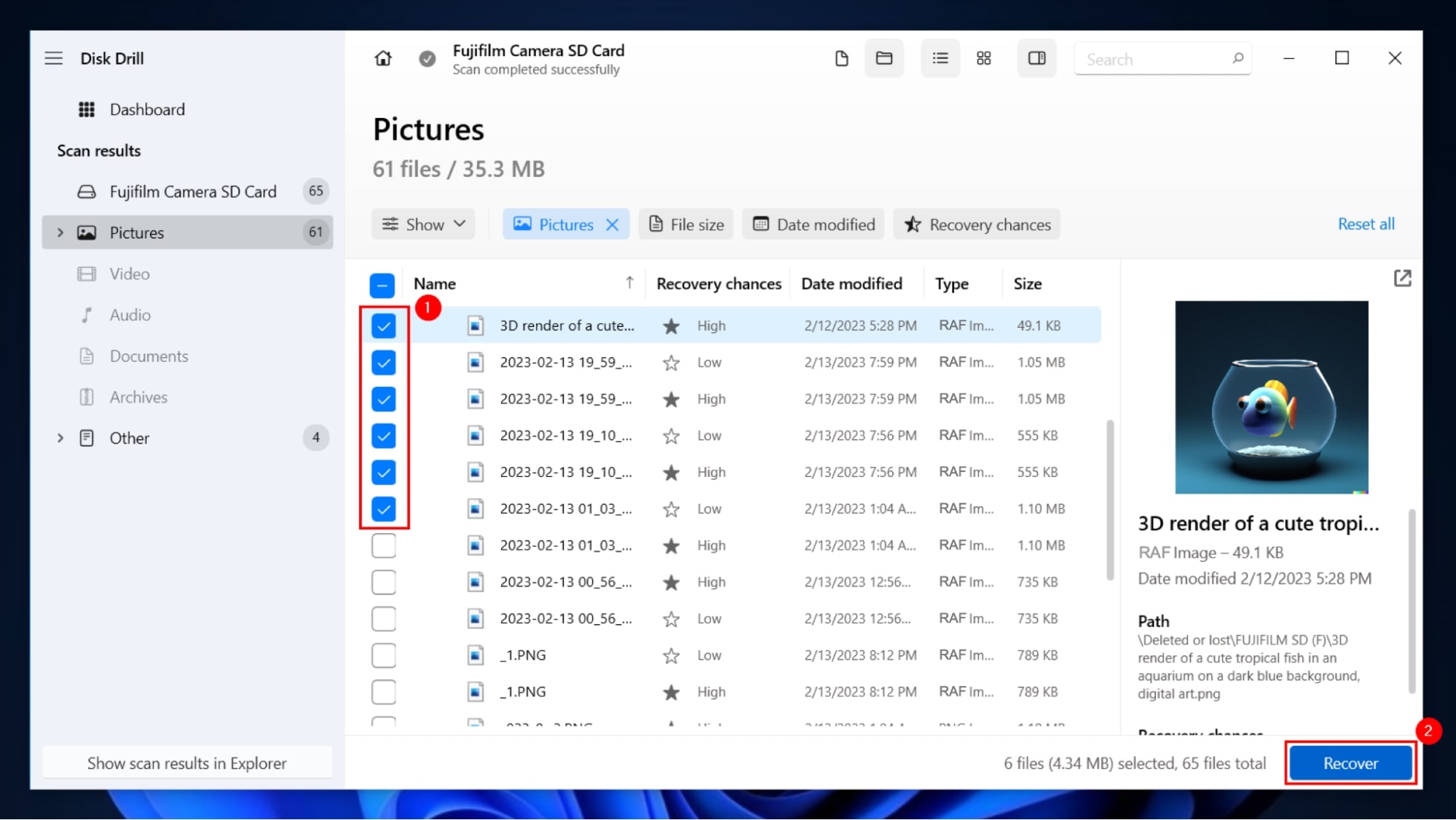
- After that, choose the destination location to recover the pictures and click Next. Select a different destination location to avoid overwriting existing data on the SD card and prevent permanent loss of the pictures you are trying to recover.

- Once the pictures are recovered, click Show recovered data in Explorer.

Method 2: Send Your SD Card to a Data Recovery Service
In most cases, where you only need to recover a few photos and your SD card is not physically damaged, you can use Disk Drill to recover deleted pictures without paying.
But in cases where your SD card is physically damaged, or your files have been severely corrupted, a data recovery software might not be able to access and retrieve these files for you. In that case, a professional data recovery service is your best chance to retrieve the deleted data because they have all the necessary tools, specialists, and knowledge for data recovery.
Here’s what you should expect from a data recovery service to recover deleted files from a Fujifilm camera:
- You find and get in touch with a reliable data recovery service through their website or contact number.
- Initiate a work order and book an evaluation with the service.
- Pack your SD card safely to drop off or ship to the data recovery center.
- The recovery service will evaluate your SD card. This step is usually free; they offer you a quote after the initial analysis.
- Once you approve the quote, the service will proceed with the data recovery process. They will retrieve your recoverable files and ship the items back to you.
How to Prevent Data Loss from Fujifilm Camera
To minimize and prevent data loss from Fujifilm cameras, follow these steps to ensure that your favorite photos and videos stay safely stored:
- 🔒 Regularly back up your photos: Backing up your photos is crucial in helping to restore your lost photos. Connect your camera to your computer or use a memory card reader to transfer your images regularly. Store your photos on an external hard drive or a cloud storage service to create multiple copies of your data. This practice ensures that you can still access your photos even if you lose data on your camera or memory card.
- 🖐️ Handle your memory card with care: Physical damage to your memory card can lead to data loss. To avoid damaging your memory card, always power off your camera before removing or inserting the card. Keep your memory card clean and dry, and store it in a protective case when not in use.
- 🔌 Safely eject your memory card: When transferring photos from your camera or memory card to your computer, always safely eject the card or device before disconnecting it. This action ensures that any ongoing data transfer is completed and prevents potential data corruption.
- 🗑️ Use the in-camera delete function sparingly: Avoid using your camera’s delete function to remove unwanted photos frequently. Instead, delete photos when you transfer them to your computer. This practice minimizes the risk of accidentally deleting important images and reduces the chances of memory card corruption.
- 💾 Use a high-quality SD card: One of the primary causes of data loss in digital cameras is faulty or poor-quality memory cards. Investing in a reputable brand’s high-quality memory card ensures better performance and minimizes the risk of data corruption. Look for cards with fast read/write speeds and a higher storage capacity to accommodate your shooting needs. Additionally, never make a rookie move of removing a memory card during file transfer. Always wait until transfer completion.
Wrap Up
There can be various reasons your files get deleted from Fujifilm camera, such as corruption, virus, SD card issues, firmware errors, or even physical damage. Fortunately, recovering photos from a Fujifilm camera is easy, and you can use third-party software like Disk Drill to get your files back. However, in case of extensive physical damage or corruption where software cannot recover your lost files, you may need to contact a professional data recovery service.
FAQ:
- Turn on your camera and navigate to playback mode.
- Access the playback menu by pressing the Menu/OK button.
- Select the "Erase" option and choose "Erase All Frames" or "Format" to delete all frames and clear the memory card.













